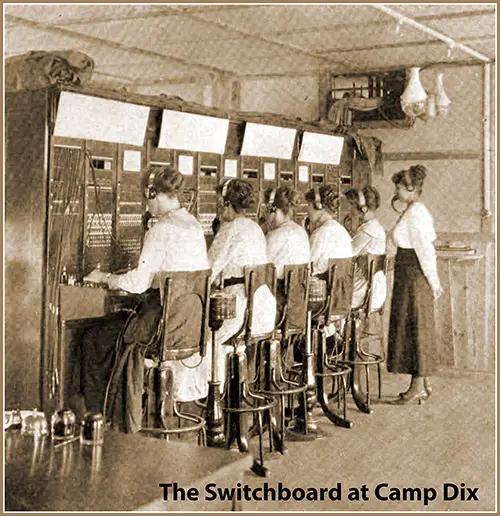Camp Dix Telephone Service

The Switchboard at Camp Dix. The Camp Dix News, 29 September 1917, p. 10. GGA Image ID # 1ce516d2bf
Development of the Telephone at Wrightown, N. J.
BY D. W. EIGNER District Traffic Supervisor. Delaware and Atlantic Telephone Co.
Keeping pace with the Government in any line of endeavor is usually a pretty tricky task, and this has been particularly true at Camp Dix. This task of not only "keeping up" but keeping ahead has been the Telephone Company since the latter part of June.
It will probably be attractive to the readers of this paper to know something about the development of the telephone at the Camp from an operating standpoint.
After a preliminary survey of the Cantonment, the Telephone Company, on June 29, installed a one-position generator-type switchboard for the temporary use of the Quartermaster's Corps and employees of Irwin & Leighton in handling the construction work at the Camp.
Ten stations and six trunk lines connected to this switchboard, three to Mount Holly and three to Pemberton. The Pemberton lines were primarily used for business terminating at Pemberton. In contrast, the Mount Holly lines took care of traffic to all other points.
As most of you know, the operation was in the hands of boy operators who lived in the exchange room. During the first day, operators handled thirty calls to out-of-town points and twenty-five calls between stations.
By July 6, the business had grown to such an extent that installing a second switchboard position was necessary. It was essential to increase the trunk line layout, with direct circuits connected to Trenton, New York, and Philadelphia. Approximately fifty stations are connected at this time, and 150 toll and 200 local calls are being handled daily.
On August 7, another position was added to the switchboard equipment to provide for the increase in business which had reached approximately 225 toll calls and 300 local calls daily.
While there was no complaint of the service during the time the generator type switchboard and stations were in service, the Telephone Company felt it should be prepared to take care of the increased business of the Camp in a more satisfactory manner than obtained, and on September 1 cut in service, a switchboard of the latest and most improved type.
At this time, the operation was put in the hands of female operators. The station equipment was changed so that telephone users would not have to turn a crank to attract the operator's attention. From comments heard all around, this seems to be a much more satisfactory arrangement to all concerned.
As an example of how telephone use has increased during the last two months, it is only necessary to give a few figures. For instance, instead of 30 toll calls per day, we now handle about 500; the number of local calls has jumped from 15 to 2000; the number of operators has increased from 2 to 15.
We now have seven switchboard positions instead of one, and during the next few weeks it is expected that six more will be added; from the six circuits in use at the time the office was opened the trunk layout has been increased to forty circuits, which gives Wrightstown direct connection to all the larger cities in this part of the country.
The building in which the Central Office is located has been provided with very attractive restrooms for the operators. Camp Dix will erect some time during the next two weeks sleeping and eating quarters for the operating force near the Central Office building.
D. W. Figner, "Camp Dix Telephone Service," in The Camp Dix News, Vol. 1, No. 7, 29 September 1917, p. 3.
